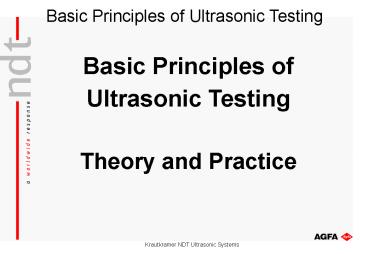Basic Principles of Ultrasonic Testing - PowerPoint PPT Presentation
1 / 42
Title:
Basic Principles of Ultrasonic Testing
Description:
Movement of the ball over time. Krautkramer NDT Ultrasonic Systems ... Atomic structures. low density. weak bonding forces. medium density. medium bonding forces ... – PowerPoint PPT presentation
Number of Views:1624
Avg rating:3.0/5.0
Title: Basic Principles of Ultrasonic Testing
1
Basic Principles of Ultrasonic Testing Theory
and Practice
2
Examples of oscillation
ball ona spring
pendulum
rotatingearth
3
The ball starts to oscillate as soon as it is
pushed
4
(No Transcript)
5
Movement of the ball over time
6
Frequency
Time
One full oscillation T
From the duration of one oscillation T the
frequency f (number of oscillations per second)
is calculated
7
The actual displacement a is termed as
a
Time
180
360
90
270
0
Phase
8
Spectrum of sound
Frequency range Hz
Description
Example
0 - 20
Infrasound
Earth quake
20 - 20.000
Audible sound
Speech, music
gt 20.000
Ultrasound
Bat, Quartz crystal
9
Atomic structures
liquid
gas
solid
- low density
- weak bonding forces
- medium density
- medium bonding forces
- high density
- strong bonding forces
- crystallographic structure
10
Understanding wave propagation
Spring elastic bonding force
Ball atom
11
start of oscillation
T
distance travelled
12
During one oscillation T the wave front
propagates by the distance ?
T
Distance travelled
From this we derive
Wave equation
or
13
Sound propagation
Direction of propagation
Longitudinal wave
Direction of oscillation
14
Sound propagation
Transverse wave Direction of oscillation
15
Wave propagation
Longitudinal waves propagate in all kind of
materials. Transverse waves only propagate in
solid bodies. Due to the different type of
oscillation, transverse wavestravel at lower
speeds. Sound velocity mainly depends on the
density and E-modulus of the material.
16
Reflection and Transmission
- As soon as a sound wave comes to a change in
material characteristics ,e.g. the surface of a
workpiece, or an internal inclusion, wave
propagation will change too
17
Behaviour at an interface
Medium 1
Medium 2
Incoming wave
Transmitted wave
Reflected wave
Interface
18
Reflection Transmission Perspex - Steel
1,87
1,0
Transmitted wave
Incoming wave
0,87
Reflected wave
Perspex
Steel
19
Reflection Transmission Steel - Perspex
Transmitted wave
Incoming wave
1,0
0,13
-0,87
Reflected wave
Steel
Perspex
20
Amplitude of sound transmissions
Water - Steel
Copper - Steel
Steel - Air
- Strong reflection
- Double transmission
- No reflection
- Single transmission
- Strong reflection with inverted phase
- No transmission
21
Piezoelectric Effect
Battery
Piezoelectrical Crystal (Quartz)
22
Piezoelectric Effect
The crystal gets thicker, due to a distortion of
the crystal lattice
23
Piezoelectric Effect
The effect inverses with polarity change
24
Piezoelectric Effect
Sound wave withfrequency f
U(f)
An alternating voltage generates crystal
oscillations at the frequency f
25
Piezoelectric Effect
Short pulse ( lt 1 µs )
A short voltage pulse generates an oscillation at
the crystals resonant frequency f0
26
Reception of ultrasonic waves
A sound wave hitting a piezoelectric crystal,
induces crystal vibration which then causes
electrical voltages at the crystal surfaces.
Electrical energy
Piezoelectrical crystal
Ultrasonic wave
27
Ultrasonic Probes
28
RF signal (short)
29
RF signal (medium)
30
Sound field
31
Ultrasonic Instrument
32
Ultrasonic Instrument
33
Ultrasonic Instrument
34
Ultrasonic Instrument
35
Block diagram Ultrasonic Instrument
36
Sound reflection at a flaw
s
Probe
Sound travel path
Flaw
Work piece
37
Plate testing
38
Wall thickness measurement
s
s
Corrosion
0
2
4
6
8
10
39
Through transmission testing
40
Weld inspection
41
Straight beam inspection techniques
42
Immersion testing
1
2
surface sound entry
water delay
backwall
flaw































